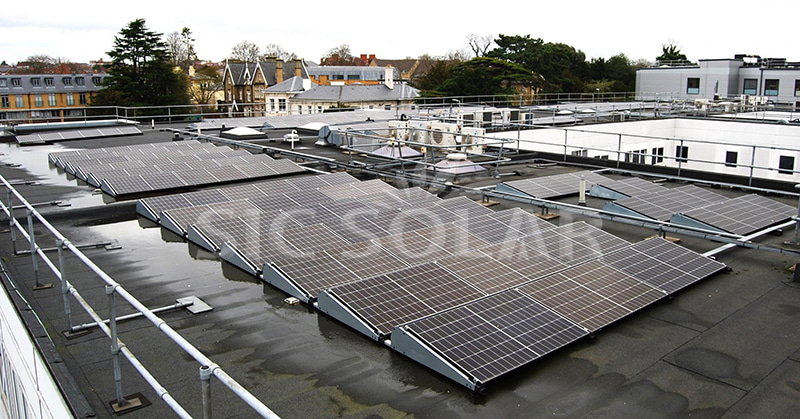As the world shifts toward renewable energy solutions, solar panels have become a popular choice for homeowners, businesses, and institutions. While rooftop solar systems are often the go-to solution, flat roof solar installations are gaining popularity for their practicality and adaptability. But when it comes to diverse climate conditions, the question arises: is a flat roof solar installation suitable for all weather environments?
1. The Basics of Flat Roof Solar Installations
A flat roof solar installation typically uses a tilted mounting system to position the solar panels at an optimal angle for energy capture. The flat roof serves as a stable platform for the panels, and the mounting system allows the panels to be adjusted for maximum efficiency.
The system is generally designed to be non-penetrative, meaning it doesn’t require drilling into the roof itself, reducing the risk of damage to the roofing material. This makes it a good solution for commercial buildings, warehouses, and residential properties with flat or low-slope roofs.
2. Flat Roof Solar Installation in Different Climates
A. Cold Climates and Snowy Conditions
In areas that experience cold weather and heavy snowfall, flat roof solar installations can offer significant advantages, but they also come with unique challenges.
- Advantages:
- Snow Melting: Solar panels can absorb sunlight, helping to melt snow faster than the surrounding areas, especially if the panels are at a slight tilt.
- Energy Production: In colder climates, solar panels tend to perform more efficiently, as they don’t overheat as they might in hotter conditions. This means energy production can remain strong throughout the winter months.
- Challenges:
- Snow Accumulation: One of the main concerns for flat roofs is the potential accumulation of snow on the panels, which can block sunlight and reduce energy production. However, with the right tilt angle, snow can slide off naturally, reducing the buildup.
- Weight Load: Heavy snow and ice can place additional stress on the roof structure, potentially causing damage or compromising the installation. It’s essential that the flat roof structure is properly reinforced to handle these conditions.
SIC Solar provides robust mounting systems designed to ensure that panels are securely positioned, even in extreme weather. Our systems are designed with strength and durability in mind, making them suitable for installations in snowy regions.
B. Hot and Sunny Climates
In hot climates, flat roof solar systems perform well, but special considerations must be made to ensure that they operate efficiently.
-
Advantages:
- Maximized Energy Production: Solar panels thrive in direct sunlight. In hot and sunny climates, flat roof systems can generate substantial amounts of electricity during the day, which is ideal for energy needs.
- Cooling Effect: With the right ventilation and installation design, solar panels can help cool down the roof by absorbing sunlight, thus reducing the building’s overall cooling needs and lowering energy consumption for air conditioning.
-
Challenges:
- Overheating: While solar panels generate more energy in direct sunlight, excessive heat can cause them to overheat, reducing efficiency. This can be mitigated with effective mounting systems that allow for proper airflow between the panels and the roof.
- Dust and Debris: In desert-like conditions or areas with high levels of dust, dirt and debris can accumulate on solar panels, reducing their efficiency. Regular cleaning may be required to keep the panels performing optimally.
SIC Solar mounting solutions ensure that the panels are tilted at the right angle to minimize overheating, and our systems allow for adequate air circulation to maintain efficiency, even in hot climates.
C. Wet and Humid Climates
In wet or humid regions, such as coastal areas or tropical climates, the durability of a flat roof solar installation depends on the materials used and the overall design.
-
Advantages:
- Efficient Energy Production: As with other climates, solar panels in humid or rainy regions can produce significant energy, especially if the roof is positioned to avoid excessive shading from nearby trees or structures.
- Longer Sun Exposure: Even in cloudy or rainy climates, there are often sufficient periods of sunlight to make solar power a viable energy source.
-
Challenges:
- Corrosion: The high humidity levels in coastal or tropical regions can cause metal components to rust or degrade over time. Using corrosion-resistant materials like stainless steel or galvanized aluminum for the mounting system is crucial.
- Moss or Algae Growth: In areas with high humidity, the potential for moss or algae growth on the roof could interfere with the solar panels. Proper maintenance is essential to prevent this buildup.
SIC Solar mounting solutions are made with corrosion-resistant materials and designed to withstand the rigors of wet and humid environments, ensuring long-lasting performance even in challenging weather conditions.
3. Best Practices for Flat Roof Solar Installations in Different Climates
A. Consider the Roof Structure
Before installing a solar system on a flat roof, it’s crucial to ensure that the roof is in good condition and can handle the additional weight. For areas with heavy snow or rain, the roof should be reinforced to accommodate these conditions.
B. Select the Right Mounting System
For all climate conditions, choosing the right mounting system is essential. SIC Solar offers a range of mounting solutions that are weather-resistant, durable, and designed for various environments. Our systems are engineered to withstand extreme temperatures, heavy rainfall, high winds, and snow loads.
- Tilted Mounting Solutions: Our systems allow for adjustable tilt angles, ensuring that solar panels are positioned at the most efficient angle for sunlight capture. This is especially important for snowy or sunny climates.
C. Regular Maintenance and Monitoring
In any climate, regular maintenance is important for maximizing the performance of your solar panels. This includes checking for snow accumulation, cleaning panels to remove dust or debris, and inspecting the mounting system for wear and tear.
